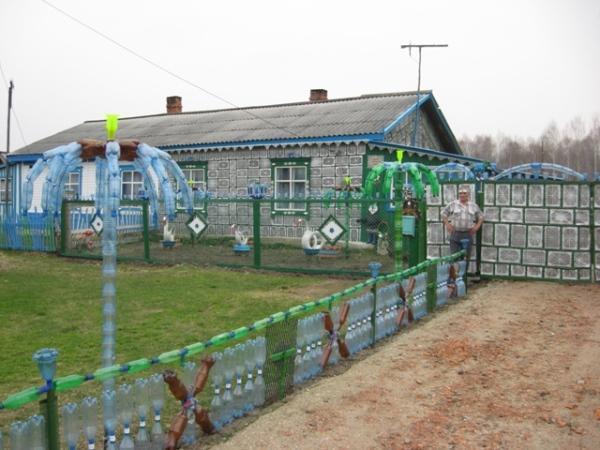We use plastic bottles with benefit
Today, the problem of waste disposal on our planet is especially acute. After all, some waste does not decompose for centuries. And in order not to litter the ground in general and your own plot in particular, you can use the trash with benefit. For example, you can create real masterpieces from plastic bottles. It is both economical and beautiful, and will help the environment.
Related article: crafts from plastic bottles for the garden and vegetable garden!

What can be made from plastic bottles?
Yes, a lot of things! For instance:
- home furniture;
- outdoor recreation area;
- gazebo;
- fence;
- sandbox;
- children's slide;
- flower bed;
- garden sculptures;
- greenhouse;
- homestead buildings;
- pool;
- country house.
Garden sculptures
Plastic bottles can make beautiful palm trees, marvelous fabulous birds, amazing monsters and very cute animal figures that can be observed in nature.




Fences
There are several options for constructing plastic bottle fences. One option is to string the top and bottom rows of the fence onto horizontal wire edges. Between them, cut-off bottles are put on edging whole bottles, one to one. "Building the pyramids" starts from the bottom. The last top row is pierced with a wire edging.

Another way of constructing fences from plastic bottles is to build a solid wall from containers with filler, fastening them with cement mortar. The walls of country houses and outbuildings are built in a similar way - this will be discussed in more detail below.

If the fence is made of a picket fence, then the lids of the containers are nailed to the upper and lower bar. Then the bottles themselves are screwed onto them. Having connected the planks together in such a way that the bottoms of the ribs enter each other, the planks are fastened together with vertical planks.

Sometimes, on the contrary, the bottoms of the bottles are nailed, and the lids are glued together. And there is also such an option when parts of containers are used, stringing them on a wire, like beads.

Furniture from plastic containers
In skillful hands, empty bottles are transformed into creative sofas, benches, armchairs, chairs and tables. It is enough only to tightly wrap the structure with tape. If you wish, you can make covers on the furniture and put pillows on the seats, armrests and under the back for softness - this is important when it is installed indoors.

Gazebos
The recreation area on the site is an important component. Very beautiful arbors are obtained from bottles - light and cozy.



Bottle buildings
But the most creative use of plastic containers is building houses and sheds from them. This building material is called “green bricks” because this recycling of plastic containers makes our planet cleaner.
To fold the wall of a house, plastic bottles are filled with barren soil, clay, or sand. Experts say that the moisture content of the filler does not play a special role here. The most important thing is to tighten the bottle cap very tightly and select containers of the same size.

"Ecological bricks" are laid in rows on the cement mortar side by side. The solution is again put on top with a sufficiently thick layer so that all containers are covered with it. Then again the bottles are laid out in a checkerboard pattern.



The bottle necks are additionally pulled together with synthetic twines, rubber cords or soft wire so that a kind of plaster mesh is obtained. It is possible to completely brick "bricks" only after they have been connected.


The wall looks very creative when the bottom drawing is cleared of the solution. Thanks to this, you can get an interesting "star pattern". But you can completely plaster the wall by hiding the building material inside.

But construction should not start from the walls. First, round vertical columns should be erected at the corners of the building - they will hold the entire structure. They will also require filled plastic bottles that are held together with cement mortar. Only the first circular row is laid on a dug hole, into the center of which reinforcement is burst and poured with concrete. Containers with filler are laid in a concentric circle, a few centimeters away from the pin, with their necks inward already on a layer of concrete. The necks are tightly pulled together with soft wire so that they touch. All gaps between the "bricks" are poured with mortar and left to "grab" for several hours.

Then the second layer of bottles is laid out, already in a checkerboard pattern. The inside of the column can be filled with broken bricks, stones, glass, slag. When the required height is reached, the laying out of the rows is stopped. The column is plastered from the outside.










Basically, the algorithm for the construction of ordinary brick houses and from plastic bottles is identical: floors are also laid, window and door frames are installed, logs for ceilings and floors are laid. Simply replacing building materials provides tremendous savings.


And the strength of one-story buildings, built from the most real trash, is in no way inferior to brick houses. And the thermal insulation of such houses is quite high.

By the way, Bolivia has been successfully implementing a program to convert plastic waste into cheap housing for several years.